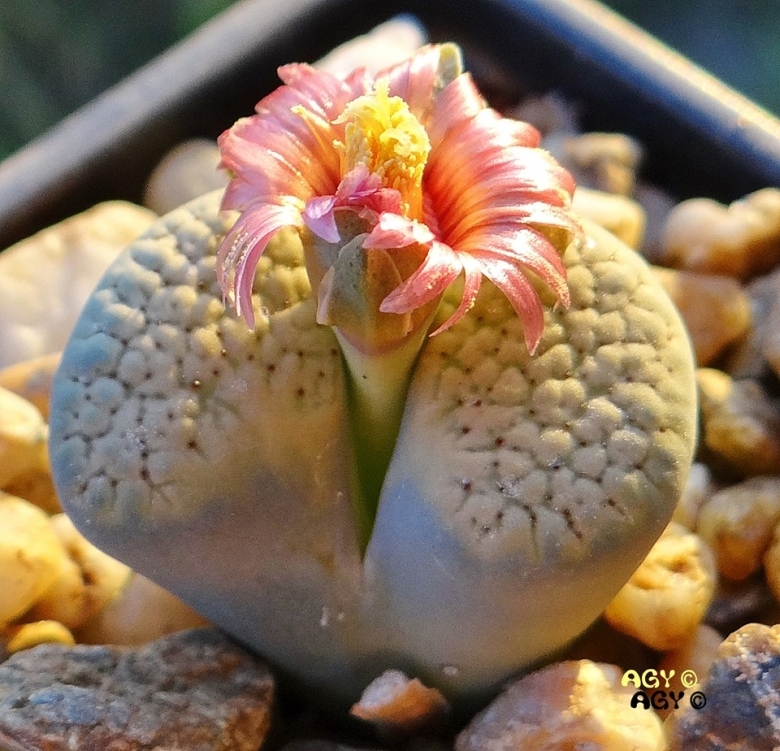
Lithops verruculosa cv. Rose of Texas Photo by: Agócs György
Origin and Habitat: Garden origin (Nursery produced cultivar)
Synonyms:
See all synonyms of Lithops verruculosa
back
Accepted name in llifle Database:Lithops verruculosa NelAnn. Univ. Stellenbosch, Reeks A, Wis.- Naturk xxi. Sect. A, No. 1, 9 (1943); cf. Nel, Lithops, 161,178 [1947].Synonymy: 14
- Lithops verruculosa Nel
- Lithops verruculosa C095 (syn. inae) 55 km SW of Prieska, South Africa
- Lithops verruculosa C120 30 km N of Vanwyksvlei, South Africa
- Lithops verruculosa C129 30 km E of Brandvlei, South Africa
- Lithops verruculosa C157 (syn. inae) 55 km ENE of Vanwyksvlei, South Africa
- Lithops verruculosa C159 30 km ENE of Vanwyksvlei, South Africa
- Lithops verruculosa C178 90 km W of Kenhardt, South Africa
- Lithops verruculosa C196 (syn. inae) 85 km S of Pofadder, South Africa
- Lithops verruculosa C198 85 km SSE of Pofadder, South Africa
- Lithops verruculosa C200B 80 km SSE of Pofadder, South Africa
- Lithops verruculosa C229B 90 km S of Pofadder, South Africa
- Lithops verruculosa var. inae (Nel) de Boer & Boom
Accepted name in llifle Database:Lithops verruculosa var. glabra de BoerSucculenta (Netherlands) 45 (7) 107-108 [Jul.1966]Synonymy: 4
Cultivars
(2):
back
Description: Lithops verruculosaSN|13065]]SN|13065]] cv. Rose of Texas is a selected form with great pink flowers instead of yellow, but all the other characteristics namely size and shape of bodies, fruits, roots etc. clearly show that they are conspecific and is indistinguishable from the standard Lithops verruculosaSN|13065]]SN|13065]]. It can therefore be identified only when in flower. Lithops verruculosaSN|13065]]SN|13065]] is recognizable for the characteristic small shiny red verruculae or pimples on the face, and shows a large variety of flower colours and pink flowers are not so unusual, but the "Rose of Texas" has always pink flowers.
Habit: It form small groups up to 8 or more heads (usually 2-4).
Bodies (Paired leave): Medium to large, up to 25-34 mm long and 15-26 mm wide at the fissure. Top flattened to slightly convex, occasionally slightly concave up to 3 cm tall, bluish with blue margins. Face whitish through yellow to bronze and pink with small raised red warts on top surface, wrinkled, the warts mainly in the wrinkles; fissure shallow bordered by a line, 4-8 mm; lobes conjunct. Face reniform; lobes equal to unequal; opaque to translucent usually without an obvious window; almost smooth to somewhat rugose. Margins dentate with small peninsulas and numerous lines, but not always clearly distinguishable; Channels slightly impressed, irregular; Islands enclosed by the grooves, somewhat irregular. Rubrications evident and numerous, with small isolated round shining warts or pimples (a feature characteristic of this species), up to 1 mm in diameter, usually situated in the channels, slightly raised. Dusky dots not visible.
Colours: Face grey or beige tinged with pink, yellow, light brown, lilac, green or blue. Windows & channels translucent greyish, brownish or reddish green, or greenish brown or bluish or greenish grey. Rubrications dark blood-red or purplish red, usually clear and slightly shiny, sometimes deeper set, covered with a bluish film, and then obscurely bluish red. Shoulders bluish grey or greyish blue contrasting with the margins.
Flowers: Small to medium sized (25-35 mm in diameter) shell-pink to rose; often with a contrasting tint or inner ring of mauve or magenta, which may extend up onto the stamens.
Fruits. Seed capsules 6-8 long 5-7 mm in diameter, (4-)5(-6)-chambered, boat-shaped, top flat. Face elliptic to almost round.
Seeds: Yellow-brown, smooth to rugose.
Subspecies, varieties, forms and cultivars of plants belonging to the Lithops verruculosa group
- Lithops verruculosa Nel: It distinguish for the raised red warts on top surface and for the variable flowers colours.
 Lithops verruculosa C095 (syn. inae) 55 km SW of Prieska, South Africa: transparent grey green, red dots.
Lithops verruculosa C095 (syn. inae) 55 km SW of Prieska, South Africa: transparent grey green, red dots. Lithops verruculosa C120 30 km N of Vanwyksvlei, South Africa: fine red pimples.
Lithops verruculosa C120 30 km N of Vanwyksvlei, South Africa: fine red pimples. Lithops verruculosa C129 30 km E of Brandvlei, South Africa: brownish grey top, red dots.
Lithops verruculosa C129 30 km E of Brandvlei, South Africa: brownish grey top, red dots. Lithops verruculosa C157 (syn. inae) 55 km ENE of Vanwyksvlei, South Africa: grey green, many raised red dots.
Lithops verruculosa C157 (syn. inae) 55 km ENE of Vanwyksvlei, South Africa: grey green, many raised red dots. Lithops verruculosa C159 30 km ENE of Vanwyksvlei, South Africa
Lithops verruculosa C159 30 km ENE of Vanwyksvlei, South Africa- Lithops verruculosa C178 90 km W of Kenhardt, South Africa
 Lithops verruculosa C196 (syn. inae) 85 km S of Pofadder, South Africa
Lithops verruculosa C196 (syn. inae) 85 km S of Pofadder, South Africa- Lithops verruculosa C198 85 km SSE of Pofadder, South Africa: red dots in transparent window.
 Lithops verruculosa C200B 80 km SSE of Pofadder, South Africa: bluish grey, bright red dots.
Lithops verruculosa C200B 80 km SSE of Pofadder, South Africa: bluish grey, bright red dots. Lithops verruculosa C229B 90 km S of Pofadder, South Africa
Lithops verruculosa C229B 90 km S of Pofadder, South Africa- Lithops verruculosa var. glabra de Boer: Light grey-blue leaves with very few red dots on top of the leaves.
 Lithops verruculosa var. glabra C025 30 km E of Kenhardt, South Africa: pinkish grey, raised red dots.
Lithops verruculosa var. glabra C025 30 km E of Kenhardt, South Africa: pinkish grey, raised red dots. Lithops verruculosa var. glabra C160 TL: 20 km SSE of Kenhardt, South Africa: light grey top, red dots.
Lithops verruculosa var. glabra C160 TL: 20 km SSE of Kenhardt, South Africa: light grey top, red dots.- Lithops verruculosa var. glabra C177 25 km SSE of Kenhardt, South Africa: pinkish grey, red dots.
- Lithops verruculosa var. inae (Nel) de Boer & Boom: Greyish green top face with blood-red dots tucked into its grooves.
 Lithops verruculosa cv. Rose of Texas S.A.Hammer: great pink flowers.
Lithops verruculosa cv. Rose of Texas S.A.Hammer: great pink flowers.- Lithops verruculosa cv. Verdigris S.A.Hammer: Green leaves.
Bibliography: Major refences and further lectures
1) Heidrun E. K. Hartmann “Aizoaceae F – Z” Springer 2002
2) Achim Hecktheuer “Mesembs, mehr als nur Lithops” Books on Demand GmbH Norderstedt. 2008
3) Desmond T. Cole & Naureen A. Cole, Uwe Beyer, Yves Delange “Les Lithops” SUCCULENTES Spécial 2008 AIAPS (now Terra seca). 2008
4) Desmond T. Cole & Naureen A. Cole “LITHOPS Flowering Stones” Cactus & Co. Libri. 2005
5) Yasuhiko Shimada “The Genus Lithops” Dobun Shoin. 2001
6) Rudolf Heine “Lithops - Lebende Steine” Neumann Verlag. 1986
7) Bernd Schlösser “Lithops – Lebende Steine” Praktische Anleitung für die Zimmerkultur. BussinessPoint MEDIA. 2000
8) Steven A. Hammer “Lithops – Treasures of the veld” British Cactus and Succulent Society. 1999
9) Desmond T. Cole “Lithops – Flowering Stones” Acorn Books 1988
10) Rudolf Heine “Lithops – lebende Steine” Neumann Verlag. 1986
11) David L. Sprechman “Lithops” Associated University Presses, Inc. 1970
12) Gert Cornelius Nel “Lithops” Hortors Limited, South Africa 1946
13) Edgar Lamb "The illustrated reference on cacti and other succulents" Blandford Press. 1978
14) Christopher Brickell, Royal Horticultural Society "RHS A-Z Encyclopedia of Garden Plants: K-Z., Volume 2" Kindersley, 2008
15) G. C . Nel “Lithops: Plantae succulantae, rarissimae, in terra obscuratae, e famailia Aizoaceae, ex Africa australi” Hortors Limited, Cape Town, South Africa 1946
16) Heidrun E. K. Hartmann "Illustrated Handbook of Succulent Plants: Aizoaceae F-Z" Springer, 2002
17) Steven A. Hammer "Lithops: Joyaux du veld" Editions Quae, 25/nov/2010
 Lithops verruculosa cv. Rose of Texas Photo by: Agócs György
Lithops verruculosa cv. Rose of Texas Photo by: Agócs György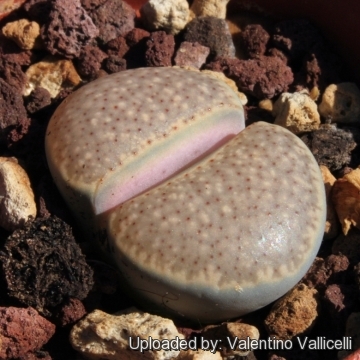 Lithops verruculosa cv. Rose of Texas Photo by: Valentino Vallicelli
Lithops verruculosa cv. Rose of Texas Photo by: Valentino Vallicelli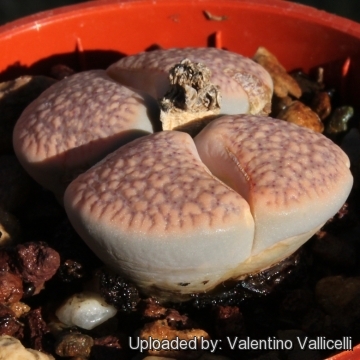 Lithops verruculosa cv. Rose of Texas Photo by: Valentino Vallicelli
Lithops verruculosa cv. Rose of Texas Photo by: Valentino Vallicelli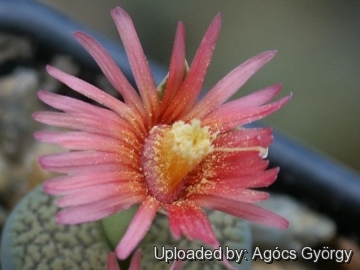 Lithops verruculosa cv. Rose of Texas Photo by: Agócs György
Lithops verruculosa cv. Rose of Texas Photo by: Agócs György Lithops verruculosa cv. Rose of Texas Photo by: Agócs György
Lithops verruculosa cv. Rose of Texas Photo by: Agócs György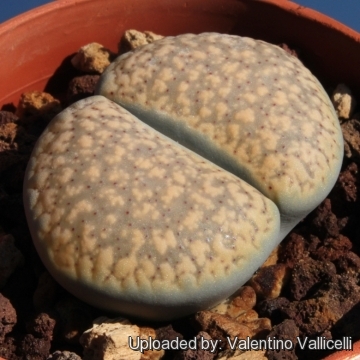 Lithops verruculosa cv. Rose of Texas Photo by: Valentino Vallicelli
Lithops verruculosa cv. Rose of Texas Photo by: Valentino Vallicelli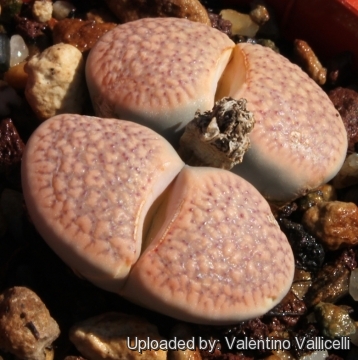 - F199A Photo by: Valentino Vallicelli
- F199A Photo by: Valentino Vallicelli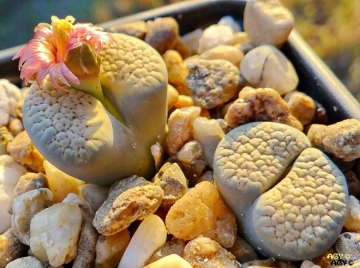 Lithops verruculosa cv. Rose of Texas Photo by: Agócs György
Lithops verruculosa cv. Rose of Texas Photo by: Agócs GyörgyCultivation and Propagation: Need an open mineral, fast draining mix and the maximum amount of light you are able to give them. The basic cultivation routine is: Stop watering after flowering. Start watering after the old leaves completely dry. (Usually late March or Early April) Water freely during the growing season, soak the compost fully but allow it to dry out between waterings, no water when cold. Some growers fertilize frequently, some hardly ever. Keep them dry during the winter. Nearly all problems occur as a result of overwatering and poor ventilation especially when weather conditions are dull and cool or very humid. This plant is best for a well lit area (Bright shade to full sun).
Remarks: After flowering in the autumn and extending through winter season the plant doesn’t need watering, but they will still be growing, the new bodies will be increasing in size extracting water from the outer succulent leaves, allowing them to shrivel away. In fact the plant in this time extracts water and nutrient stored in the outer succulent leaves, allowing them to dehydrate relocating the water to the rest of the plant and to the new leaves that form during this period until the old leaves are reduced to nothing more than "thin papery shells".
Your Photos
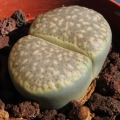
by Valentino Vallicelli




















